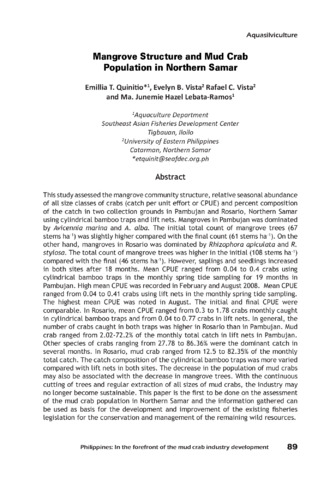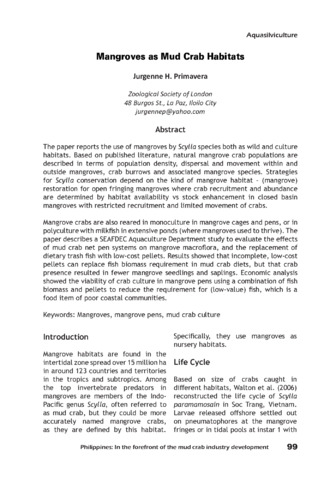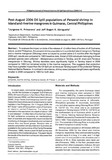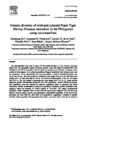Mangrove structure and mud crab population in northern Samar
Share
Abstract
This study assessed the mangrove community structure, relative seasonal abundance of all size classes of crabs (catch per unit effort or CPUE) and percent composition of the catch in two collection grounds in Pambujan and Rosario, Northern Samar using cylindrical bamboo traps and lift nets. Mangroves in Pambujan was dominated by Avicennia marina and A. alba. The initial total count of mangrove trees (67 stems ha-1) was slightly higher compared with the final count (61 stems ha-1). On the other hand, mangroves in Rosario was dominated by Rhizophora apiculata and R. stylosa. The total count of mangrove trees was higher in the initial (108 stems ha-1) compared with the final (46 stems ha-1). However, saplings and seedlings increased in both sites after 18 months. Mean CPUE ranged from 0.04 to 0.4 crabs using cylindrical bamboo traps in the monthly spring tide sampling for 19 months in Pambujan. High mean CPUE was recorded in February and August 2008. Mean CPUE ranged from 0.04 to 0.41 crabs using lift nets in the monthly spring tide sampling. The highest mean CPUE was noted in August. The initial and final CPUE were comparable. In Rosario, mean CPUE ranged from 0.3 to 1.78 crabs monthly caught in cylindrical bamboo traps and from 0.04 to 0.77 crabs in lift nets. In general, the number of crabs caught in both traps was higher in Rosario than in Pambujan. Mud crab ranged from 2.02-72.2% of the monthly total catch in lift nets in Pambujan. Other species of crabs ranging from 27.78 to 86.36% were the dominant catch in several months. In Rosario, mud crab ranged from 12.5 to 82.35% of the monthly total catch. The catch composition of the cylindrical bamboo traps was more varied compared with lift nets in both sites. The decrease in the population of mud crabs may also be associated with the decrease in mangrove trees. With the continuous cutting of trees and regular extraction of all sizes of mud crabs, the industry may no longer become sustainable. This paper is the first to be done on the assessment of the mud crab population in Northern Samar and the information gathered can be used as basis for the development and improvement of the existing fisheries legislation for the conservation and management of the remaining wild resources.
Suggested Citation
Quinitio, E. T., Vista, E. B., Vista, R. C., & Lebata-Ramos, M. J. H. (2017). Mangrove structure and mud crab population in northern Samar. In E. T. Quinitio, F. D. Parado-Estepa, & R. M. Coloso (Eds.), Philippines : In the forefront of the mud crab industry development : proceedings of the 1st National Mud Crab Congress, 16-18 November 2015, Iloilo City, Philippines (pp. 89-98). Tigbauan, Iloilo, Philippines: Aquaculture Department, Southeast Asian Fisheries Development Center.
Subject
catch composition  ; Catch/effort; dominant species
; Catch/effort; dominant species  ; mangrove swamps
; mangrove swamps  ; mangroves
; mangroves  ; marine crustaceans
; marine crustaceans  ; population number
; population number  ; population structure
; population structure  ; resource conservation
; resource conservation  ; Seasonal variations; seedlings
; Seasonal variations; seedlings  ; species diversity
; species diversity  ; sustainability
; sustainability  ; Scylla; Avicennia alba; Avicennia marina; Rhizophora apiculata; Rhizophora stylosa; Philippines
; Scylla; Avicennia alba; Avicennia marina; Rhizophora apiculata; Rhizophora stylosa; Philippines
 ; Catch/effort; dominant species
; Catch/effort; dominant species  ; mangrove swamps
; mangrove swamps  ; mangroves
; mangroves  ; marine crustaceans
; marine crustaceans  ; population number
; population number  ; population structure
; population structure  ; resource conservation
; resource conservation  ; Seasonal variations; seedlings
; Seasonal variations; seedlings  ; species diversity
; species diversity  ; sustainability
; sustainability  ; Scylla; Avicennia alba; Avicennia marina; Rhizophora apiculata; Rhizophora stylosa; Philippines
; Scylla; Avicennia alba; Avicennia marina; Rhizophora apiculata; Rhizophora stylosa; Philippines
Related items
Showing items related by title, author, creator and subject.
-
Mangroves as mud crab habitats
Primavera, Jurgenne (Aquaculture Department, Southeast Asian Fisheries Development Center, 2017)The paper reports the use of mangroves by Scylla species both as wild and culture habitats. Based on published literature, natural mangrove crab populations are described in terms of population density, dispersal and ... -
Post-August 2006 oil spill populations of Penaeid shrimp in island and riverine mangroves in Guimaras, central Philippines
Primavera, Jurgenne; Abroguena, Jeff Bogart (University of the Philippines Visayas, 2009)To evaluate the impact on biota of the release of arrow up million liters of bunker oil off Guimaras Island, Central Philippines, the penaeid shrimp populations in a protected island mangrove (Tandog) and a riverine mangrove ... -
Genetic diversity of wild and cultured black tiger shrimp (Penaeus monodon) in the Philippines using microsatellites
Xu, Zhenkang; Primavera, Jurgenne; de la Peña, Leobert D.; Pettit, Priscilla; Belak, Jane; Alcivar-Warren, Acacia (Elsevier, 2001)Six microsatellites were used to study (1) the genetic diversity of wild Penaeus monodon shrimp from four geographic regions (Palawan, Quezon, Capiz and Negros Occidental-W) in the Philippines, and (2) its association ...




